Fitbit was quick on the follow-up of the success of their “first smartwatch”, the Ionic, as they launch yet another one in the form of the Fitbit Versa. Although, not much really changed except for the design and the loss of one key feature. So, is it worth picking up over the Ionic? Let’s find out in our review!

Table of Contents
The Fitbit Versa follows the circular smartwatch design we’ve all been accustomed to, which is entirely different from the boxy feel of the Ionic. The body itself is aluminum and is sturdy and well-built. Some might prefer this style over the boxed one, though others may feel its too generic. Thankfully, we have an array of different strap choices to spice up our Versa’s bland looks.

Up front, you’ll be greeted by the 1.34-inch LCD touch display that’s protected by Sapphire Glass. Just below it is Fitbit’s logo. The screen itself has good color accuracy and reproduction and icons are crisp and sharp. Brightness is also high enough for outdoor use, which should be the case since it will be used out in the open a lot. Overall, it has a beautiful, albeit tiny, screen for a smartwatch.

At the left, we have the power/lock/back button while at the right we have two extra buttons for device navigation. All of the buttons have a smooth texture.
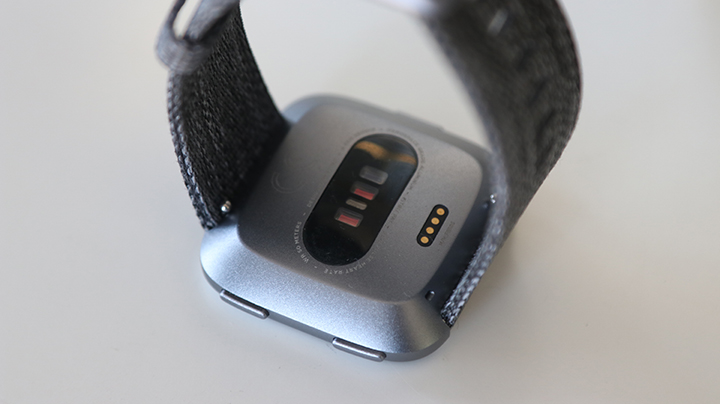
At the bottom of the device are the optical heart rate sensor, SpO2 sensor, accelerator, motion-detection sensor, and the charging port.
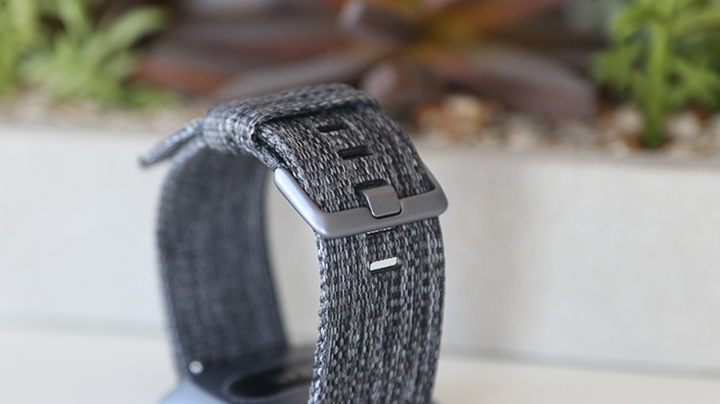
The watch has a pin-type strap mechanic. Although, a little more secure than the Ionic’s quick release setup, replacing straps can sometimes become a little tricky, even kind of frustrating. If you’re using one of the special edition straps, there are times when the end of the straps get snagged by the pin or just generally blocks it from getting inserted to the locks properly.

Like the Ionic, the Versa is equipped with up to 50 meters of water resistance. Running in the rain, swimming, and even showering with the device is certainly possible.

The Fitbit Versa uses the company’s own smartwatch OS. Pre-installed apps are all homebrew but users can add a few more via the Fitbit app. The UI is clean and simple and navigation is straightforward. The entire navigation though received an overhaul and now works differently than what we’ve experienced with the Ionic. This is thanks to the updated version 2.0 of Fitbit’s OS, which Ionic users also have access to.
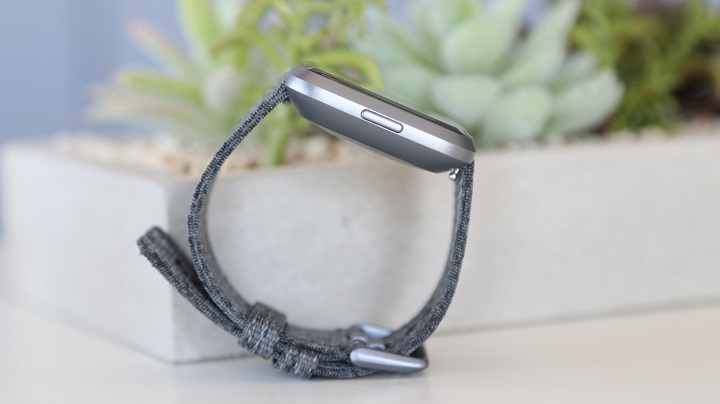
Navigating through the dashboard is now quicker, you now just have to swipe up from the clock face to access fitness information such as steps taken, heart rate, miles traversed, and the like. Previously this was done by pressing the top-right button. As for those buttons, they now serve as quick button shortcuts for the apps on your Versa — The upper right button opens up the first, top right app while the lower right button opens up the first, bottom left app.
Pressing and holding the left power/lock/back button now opens a quick access menu to the music controls and settings.

Speaking of the mobile app, at the initial setup, you’ll be prompted to download it and pair the Versa with your smartphone. The app will then automatically update and set-up the smartwatch. After that, you’re all set to use the Versa. The mobile app itself serves as a central hub and operation center of the smartwatch.
From here, you can install homebrew and third-party apps, change watch faces, and even access and monitor fitness information. Other than that, the app includes a user manual and other settings you can tinker with.

Like the Ionic, one of the Versa’s weaknesses is in its app ecosystem. While Fitbit OS version 2.0 brought in a lot of app support, it’s still nowhere near the customizability you can get with the likes of Android Wear or Apple’s watchOS. Still, you can’t help but appreciate Fitbit’s effort in continuing to push more apps into their ecosystem.

Another caveat that they did not update is the Versa’s measly 2.5GB of storage along with the manual transfer of music via the Fitbit software from your computer to the smartwatch. Although, at least this time we now have Deezer support for music streaming.
The Versa is also equipped with Fitbit Pay, though we still have no means of taking advantage of this as major local banks have yet to show support.
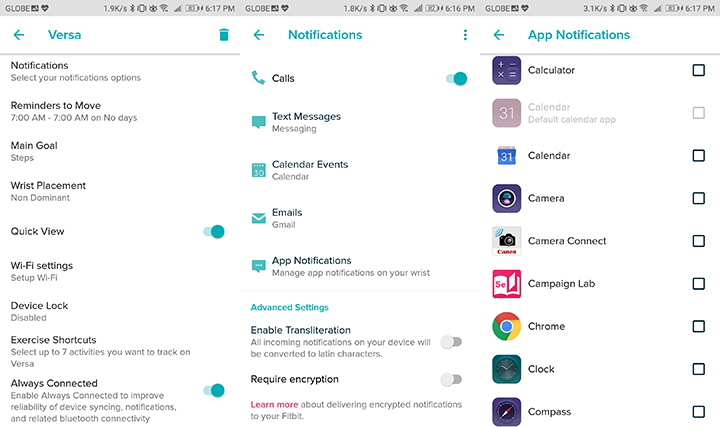
The Versa is equipped with most of the essential connectivity options. It has WiFi, NFC, and Bluetooth 4.0. As for the aforementioned loss of one key feature, that is the GPS. So sadly, users can no longer leave their smartphone behind if they wish to fully utilize the Versa when they’re out for a run.
Again, like the Ionic, to maintain sync between the Versa and your device, you’ll have to keep your Bluetooth and GPS toggled, which will certainly drain the battery of your smartphone.

Battery life is almost on par, if not the same, as with the Ionic, that is if you compare them without GPS usage. The Versa can last up to 5 days on standby and general use and about 8-10 hours when listening to music, which is pretty impressive and very convenient.
Speaking of charging, juicing up the device takes only about 40mins to an hour. This time around, instead of just having a magnetic cord, the Versa needs to be docked for charging, which can be an inconvenience at times. We would’ve liked if Fitbit maintained the magnetic cord instead.

The Fitbit Versa boasts strong fitness features for a smartwatch. The company once again proved their mastery of crafting fitness devices. It may look bland on its own but the various strap choices are more than enough to make it look sassy. Couple that with a good display and build and you have an almost perfect fitness companion. Though it does have some caveats.
Sadly, it still carries over the downsides of the Ionic due to the lack of a strong app ecosystem and the tedious software setups and music transfers. Although, the UI is now snappy and more responsive than with the Ionic.
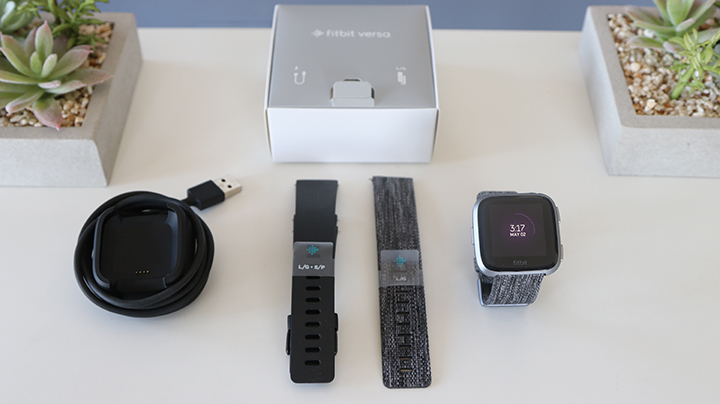
With an asking price of Php 13,890USD 237INR 20,065EUR 225CNY 1,724, the Versa is still in for a tight fight with its competitors, including Fitbit’s own fitness trackers. Not to mention, the special edition, priced at Php 15,590USD 266INR 22,521EUR 253CNY 1,935, is in the same territory as the Ionic. Accessories too are a bit of a pain as they range from Php 1,899USD 32INR 2,743EUR 31CNY 236 to Php 5,499USD 94INR 7,944EUR 89CNY 682, making customization quite pricey. The Versa is pretty much like a toned-downed and re-skinned Ionic, so if you’re tight on budget then it is surely worth getting over Fitbit’s “first smartwatch”.
Fitbit Ionic specs:
1.34-inch LCD display @ 300 x 300 pixels
Sapphire Glass
3-axis accelerometer
3-axis gyroscope
Optical heart rate monitor
Altimeter
Ambient light sensor
Vibration motor
WiFi antenna (802.11 b/g/n)
Bluetooth 4.0
GPS
NFC (Special Edition)
SpO2 sensor
water resistant to 50 meters
Up to 4 days battery (standby), 10 hours (Music)
What we liked:
What we didn’t like:

YugaTech.com is the largest and longest-running technology site in the Philippines. Originally established in October 2002, the site was transformed into a full-fledged technology platform in 2005.
How to transfer, withdraw money from PayPal to GCash
Prices of Starlink satellite in the Philippines
Install Google GBox to Huawei smartphones
Pag-IBIG MP2 online application
How to check PhilHealth contributions online
How to find your SIM card serial number
Globe, PLDT, Converge, Sky: Unli fiber internet plans compared
10 biggest games in the Google Play Store
LTO periodic medical exam for 10-year licenses
Netflix codes to unlock hidden TV shows, movies
Apple, Asus, Cherry Mobile, Huawei, LG, Nokia, Oppo, Samsung, Sony, Vivo, Xiaomi, Lenovo, Infinix Mobile, Pocophone, Honor, iPhone, OnePlus, Tecno, Realme, HTC, Gionee, Kata, IQ00, Redmi, Razer, CloudFone, Motorola, Panasonic, TCL, Wiko
Best Android smartphones between PHP 20,000 - 25,000
Smartphones under PHP 10,000 in the Philippines
Smartphones under PHP 12K Philippines
Best smartphones for kids under PHP 7,000
Smartphones under PHP 15,000 in the Philippines
Best Android smartphones between PHP 15,000 - 20,000
Smartphones under PHP 20,000 in the Philippines
Most affordable 5G phones in the Philippines under PHP 20K
5G smartphones in the Philippines under PHP 16K
Smartphone pricelist Philippines 2024
Smartphone pricelist Philippines 2023
Smartphone pricelist Philippines 2022
Smartphone pricelist Philippines 2021
Smartphone pricelist Philippines 2020
Allan says:
Hi! I would like to ask other smartwatch brands that is good but not too pricey?? What would you recommend? Is the Xiaomi brand ok? Thanks!